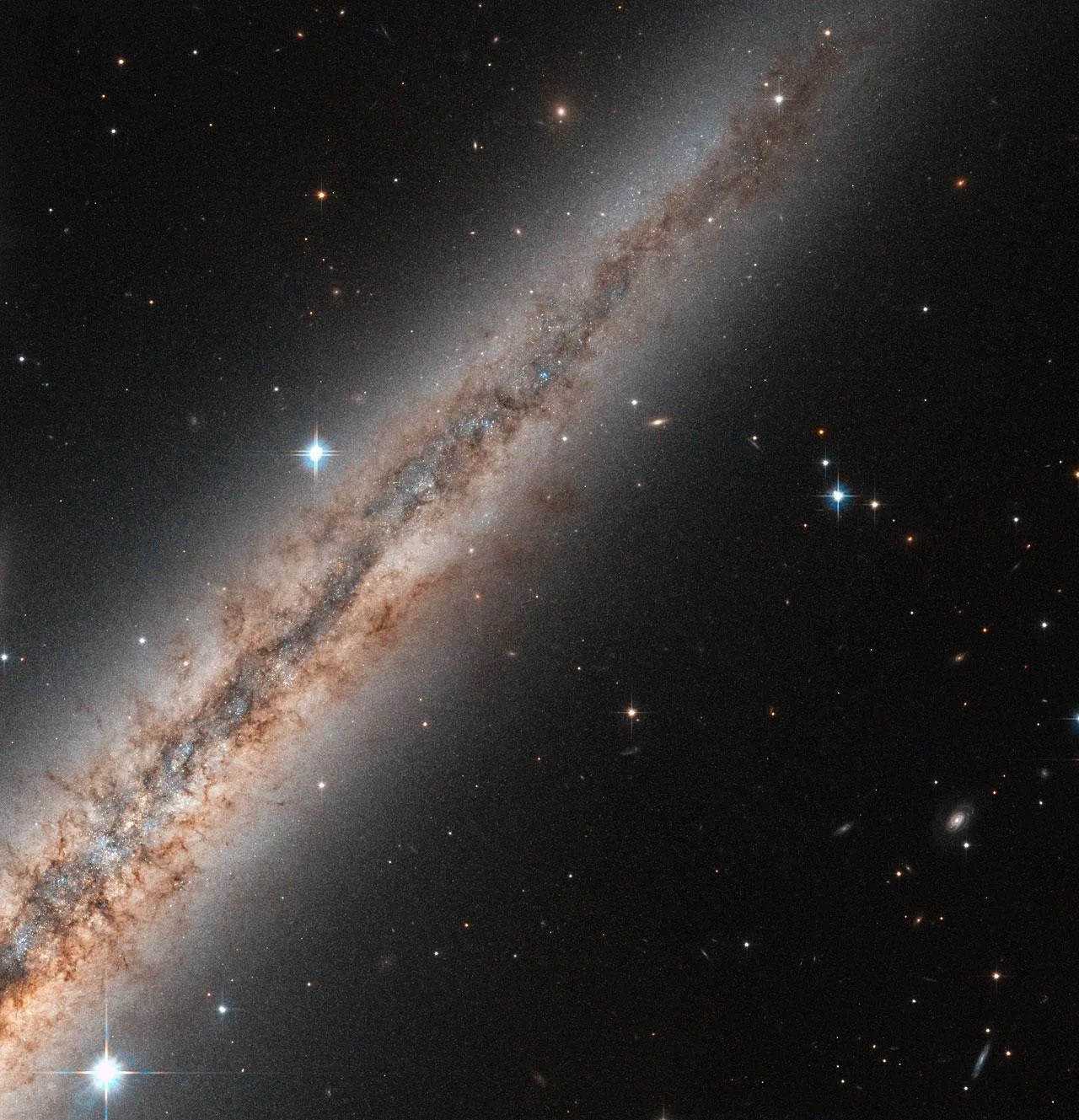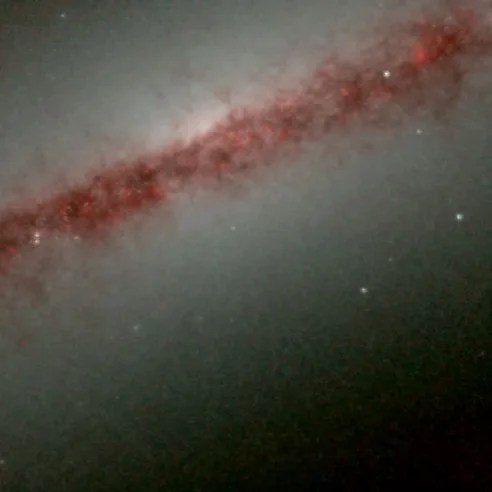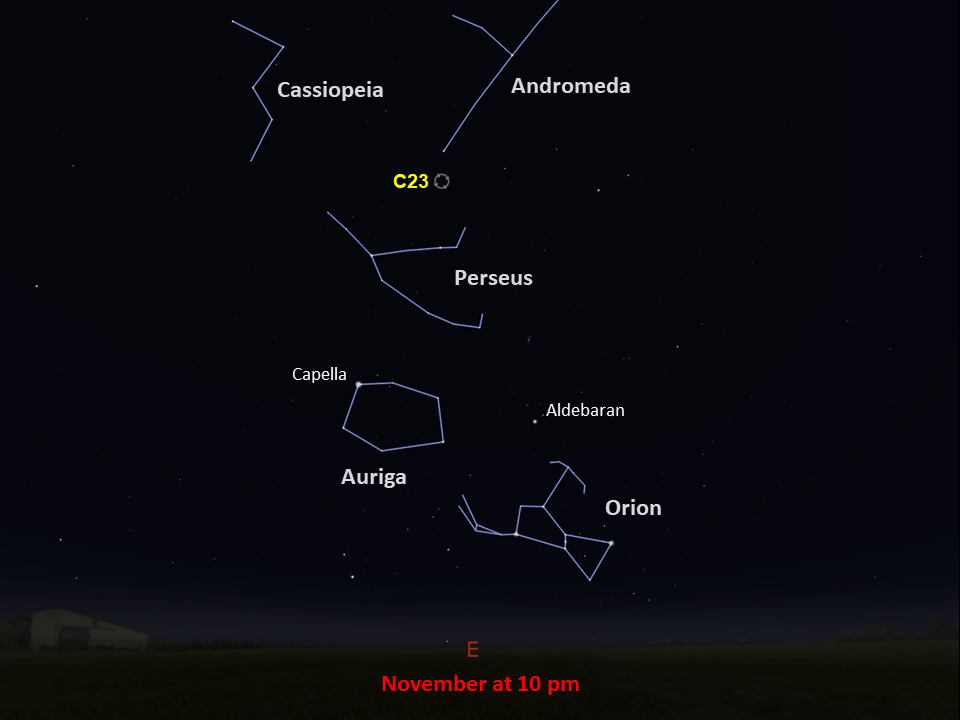Caldwell 23
Spanning some 100,000 light-years, Caldwell 23 is seen exactly edge-on, revealing its thick plane of dust and interstellar gas.
Distance
35 million light-years
Apparent Magnitude
10.0
constellation
Andromeda
object type
Spiral Galaxy

If we could travel across space and time to see our own galaxy from the outside looking in, it would probably look a lot like Caldwell 23. This spiral galaxy, also cataloged as NGC 891, is about 35 million light-years away from Earth in the constellation Andromeda. Sir Patrick Moore, creator of the Caldwell catalog, once said the full galaxy looks like “two fried eggs clapped back to back.” In this Hubble image, taken in visible and infrared light using the Advanced Camera for Surveys, the “yolk” portion of the galaxy is out of the picture beyond the lower left corner. A few foreground stars from the Milky Way shine brightly, while more-distant galaxies can be seen in the lower right corner of the image.

Astronomers used Hubble’s observations of Caldwell 23 to learn more about the structure and evolution of spiral galaxies. One of their findings helped identify the source of Caldwell 23’s galactic halo. The halo surrounds the galaxy and primarily contains old stars, some of which are grouped together in large, sphere-shaped collections called globular clusters. The source of this halo material has been unclear, since theoretically it could either originate in the galaxy or be gravitationally pulled in from the area surrounding the galaxy. Scientists using Hubble found that Caldwell 23’s halo is similar in composition to other material in the galaxy, which suggests that the halo material was expelled from within the galaxy.
This Hubble image shows wispy tendrils of dust and gas branching off from the plane of the galaxy into the halo. Astronomers believe these structures formed as material was ejected outward by supernovae or intense star formation activity. When massive stars light up at birth or explode at death, they produce powerful winds that can blow dust and gas over hundreds of light-years of space.
Caldwell 23 was discovered by astronomer William Herschel in October 1784. The galaxy has a magnitude of 10, so use a telescope to see it, away from any sources of light pollution. Under ideal conditions you can make out the galaxy’s central dark lane. Autumn night skies in the Northern Hemisphere will provide the best view. In the Southern Hemisphere, look for Caldwell 23 in the springtime.
For more information about Hubble’s observations of Caldwell 23, see:
Edge-on Beauty: NGC 891
Hubble’s Infrared Galaxy Gallery

Glossary
Galactic Halo - A roughly spherical collection of old stars and globular clusters surrounding a spiral galaxy.
Globular Cluster - A spherical group of stars that are gravitationally bound to each other, with most of the stars concentrated at the cluster’s center.
Magnitude - The brightness of an astronomical object, represented by a number; bright objects have low numbers on the magnitude scale, while dim objects have high numbers.
Spiral Galaxy - A galaxy characterized by its spiral structure, with star-filled arms that extend out from the center of the galaxy and host regions of star formation.
Supernova - The explosion of a massive star at the end its life, which ejects material into space and causes the star to temporarily brighten in our sky.
Explore Hubble's Caldwell Catalog
The following pages contain some of Hubble’s best images of Caldwell objects.

Caldwell 1
Also known as NGC 188, this group of stars formed from a large cloud of gas making the stars roughly…

Caldwell 2
This shell of gas is expanding outward, away from the dying star within.

Caldwell 3
This barred spiral galaxy was first spotted by British astronomer William Herschel in April 1793 in the constellation Draco.




